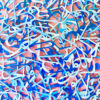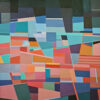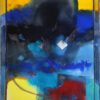The question about memory in the age of digital globalization, in which computers have replaced human memory, does not carry the same tone that it carried when our ancestors asked about it. Transforming dead bodies into mummies to ensure their eternality is the oldest technique of memory, which appeared in old Egypt, the oldest of civilizations that invented writing, arts, mythologies, and gods. However, today, memory has changed its terminology, as the question would be now “How many Gigabytes is the digital memory of your computer?”, so that each one has its own digital capability to store data within a digital mind, one that we do not need to carry around in our brains, but instead bestowed upon computers as a core part of our post-digital identities. However, arts stand in an existential territory that is completely different from digital memory… arts introduce themselves as visual, musical, and poetic narrations of a memory that they invent with their installments, paintings, music, novels, and theaters. Art, in that sense, is a form of inventing memory to open “new existential territories”, according to a delighted statement by Felix Guattari, the French philosopher and psychoanalyst.(1) We are against a field of investing in future making by growing a plant of hope. But how can art achieve the metaphor of passing from the memory of the past to igniting hope in the future? How can artistic impact create this chronological passing? Through narrations or through catastrophic dystopia? How could art paint the shining side of the catastrophe?
The questions of art and memory entail various and complicated battles among memory, history, time, oblivion, and death in addition to the cultural identities and the collision of fundamentality… it is a battle of titans around the meaning of existence between those who favor narrations against those who favor Logos, truth, and candid ideas, i.e. among the advocates of Pharmakon (Poison and Remedy in Greek) and the advocates of Organon (Logic Standard), there is a battlefield for “meaning wars”, to use the elegant title by Fathi Al Maskini.(2) Art, since the days of Plato to the days of Nietzsche, has been regarded as oblivion, but Derrida assigned the duty of memory to art, i.e. to write the memory of the victims, absentees, and the voiceless or to use Derrrida’s words “Mourning what’s left”(3)… should art then forget and return to the initial childhood innocence, or should it rather write the memory of those in pain, emarginated, and those without a homeland?
1- On the question of memory:
In his book “Memory, history, forgetting”(4), French philosopher Paul Ricœur raises a question on how can we represent something from the past, in the present? This question is the main paradox that memory deals with considering that it is our core link with time. But what is it that we remember from the past and what is it that we forget? Which memory acts on that matter, is it the personal memory or the collective memory? Plato advocates for memory, and he considers that knowledge is memorization, and ignorance is forgetting. Also, German philosopher Schopenhauer says “madness is the torn thread of memory”, while Freud considers remembering to be the remedy for ill souls, we are healed when we remember. Moreover, Nietzsche goes as far as to say that memory is made out of our pains. Unlike Nietzsche, Derrida considers that there is a duty to remember in order to give justice to the victims. Another philosophical approach is taken by Deleuze where he states that arts required a counter-memory or a short-term memory. We read in his book “A Thousand Plateaus”, co-written by Félix Guattari, the following “A painting is done at close range, even if it is seen from a distance… Even writers write with short-term memory, whereas readers are assumed to be endowed with long-term memory.”(5)
But why do we make memory? To acknowledge a debt we owe to the victims, according to Derrida, meaning that every philosophy that stands up for memory ends up with an interpretation of forgiveness. The narrations of memory are considered some kind of apology for the horrors of the past, in order to rectify the paths of the future.
In his book “Thoughts out of Season”(6), Nietzsche harshly criticizes the historical tendency that dominated in the 19th century as to how history does not need to be remembered or simulated, but only continually overcome. Every past deserves conviction on one measure only, which is life. Thus, history shall not be glorified or divinized. A man needs to forget to make history, and criticizing history is needed just as much as we need to know it. He even goes on to say that respecting history is not what we’re required to do, instead, we need to have the courage to make history. Therefore, Nietzsche considers that all of the modern art is just a major malfunction between history and life. The question then here is how much life needs history, or memory, so it won’t fade under its burdens? Nietzsche gave a major value to forgetting over memory, thus flipping the typical positioning which places memory at the top of the ladder as the strongest power, thus considering history to be a threat to the living capabilities of a culture. He thought that the excess of historical studies is annoying to the living.
2- Writing – Memory – Love:
The opening of The Phaedrus, by Plato,(7) starts with a lovely scene: Socrates and a Greek young man, Phaedrus, taking a philosophical walk down the Ilisos River at noon, conversing about life, after attending a lesson on love given by logographos Lysias. Phaedrus was holding a book with his left hand, hiding it under his coat, which was Lysias’s book on love. Then a question is raised about the content of the book. The dialogue then takes several curves around the soul, discourse, then around writing, for it to turn into a trial where Socrates prosecutes writing for murdering memory. Behind this accusation, there is a symbolism of what Plato calls himself “Father Murder” in the Sophist Dialogue, in fact, behind this prosecution of writing, Plato is declaring war on sophists, logographos, poets, and priestesses. The battle here about memory is between writing on the fabrics of the inner self and writing on the water surface.(8) The first is a living eternal writing while the latter is dead and obsolete. The first relies on truth, i.e. existence and fatherhood, while the second relies on memory, i.e. on a dead orphan text. Meaning that the philosophical battle that Socrates declares here is about who is taking control of the Greek memory.
How to pass from the mythos to the logos? i.e. how was philosophy created? The answer lies in the victory of the oral memory, or living words, overwriting memory, meaning the victory of that Egyptian king, the oriental Pharaoh, against the inventor of writing… the battle is purely oriental. This battle against the mythos or the myth could be interpreted also as a battle against the old orient for being the cradle of early legends. The victory of philosophy is in some way a win for the West against the East. For that, the legend of the East is evoked to establish the logos of the west, which is what Socrates did when he evoked the mythology about the God of writing. The ancient Egyptian mythology that narrates the time when Thoth, the God of writing and wisdom, and the messenger of gods for all knowledge, and responsible for prosecuting the dead, visited the Pharaoh and the master of all gods, and presented a gift, which was writing, as a remedy for the souls and preserving memory. Socrates used this mythology in some kind of philosophical scheme in order to prosecute writing. He then was advocating the Pharaoh King and reinstating the same decision that considered writing as a deadly knowledge that kills the memory.(9) Socrates is then advocating the king against the writer, and the logos against the mythos. Mythos is scripted as a memory, like Homer did when he recorded the wars of Greece and the history of their gods in the Iliad and the Odyssey. While Plato’s intention was to establish the logos that is built on living discourse, or the art of dialectic and dialogues with the self. Socrates’s end was to defeat the sophist and all other similar discourses that overtook the memory of Athens youth. Logos, i.e. the philosophical discourse, stands in this interpretational ground against poets, art deities, and priestess, which is against Home, Protagoras, Lysias, and Diotima also, the priestess and soothsayer who taught wisdom to Socrates himself.
Logus for Socrates is a living entity, with a beginning and end, and a father that is existence itself, meaning the full and living presence of the idea that the memory established by Plato is a living memory taking an oral form. This is against the memory that relies on writing, which is a dead text that is parentless… and to what extent can we endure being orphaned? How can we shift to writing as a field of a memory that needs no roots, but just scatters of what is to come? That is a battle Derrida is fighting with Pharmakon in his book Plato’s Pharmacy where he advocates the absentees, those scattered on the verge of talking, those who are extra to the text, those who rebelled against the authority of fathers, and those who renounced the logos. Those are the ones who have the duty of memorizing, as a religion, as a promise, and as forgiveness.
3- Art and the memory of victims (Derrida):
Art is the only field that’s capable of handling the duty of memory. However, the memory that artworks work on creating is specifically the memory of the victims, the absentees, and those who are denied speaking. That was Derrida’s thesis in his book Memoirs of the Blind.(10) We shall here differentiate between memory and history. So while history is written by the victorious and tyrants, memory is written by the sufferings of victims and marginalized. We shall also here refer to the conundrum of memory as captured by Derrida: in the sense that art is the promise of bringing justice to the victims, and in the sense that art cannot restore the past just by evoking it in the artistic traces, that is because evoking the past means revealing and displaying an open wound. Therefore, each artistic trace is some kind of negotiation with the invisible, or mourning it by turning it into an offering and a space for forgiveness. When art evokes the memory of victims, it is then apologizing for the sins that were committed against them. It is then not possible to separate the art piece from its pre-history, from its deep memory and its atrocities in which it is implicated. Art in that sense works on the dark side of every memory, yet still, art cannot be involved with a totalitarian vision of history, since it always comes as a discontinuity in a pattern that is content with its axioms. So when an artistic trace appears, it is usually a unique event, or it is the initial event that cannot be repeated or simulated. It is a sudden moment, untranslatable, like an ancient Babylonian language. The memory of art is not a product of an original paradigm, but instead of what is to come. In other words, an artistic trace invokes a reckoning, as it apprises of something that is coming in a flash-forward, so it does not originate from some source, but derives from a certain future that is unpredictable and impossible. The questions of memory, in that sense, imply a collision between fundamental perceptions and catastrophic perceptions. It is because memory here changes its titles from a memory of the past to a memory of what’s to come since art is not required to engage in a narration about the misery of the world all the time. It is true that an artistic trace carries appeals of the memory, but in different voices that are occurring. In the face of the ontology of presence, we ought to consider the aesthetics of absence that liberate memory from the battles of the look, the sight, the contemplation, the visible, and clarity. Those are all binaries of the western logos, which we could trace back to Plato’s Pharmakon, and its completed expression in western modernity, from Descartes up until Heidegger’s Originality. What’s needed then is a liberation of the memory from the old lexicon and provide it with a new expressional system. That is because memory is created with every art piece, without simulating anything from the past. Therefore, the past shouldn’t be glorified and instead, we need to innovate our Selves all over again. We are not mere already-existent identities, we’re innovations, Becomings, and artistic traces. Art cannot be copied, and it does not translate identities, but what American philosopher Richard Rorty calls “re-creating ourselves”(11)
How does art invent memory differently? A creative memory cannot be accomplished but through readings for the artistic trace. Those readings do not claim to comprehend the creator’s intention, as the artist ceases to have any will to say or tell the truth – after the incident of the writer’s death. An artistic trace does not last, does not return, and does not live differently except through interpretation, deconstruction, criticism, and wandering amidst other languages in some form of responsibility towards the other… this is why an artistic trace has no memory except within a meticulous lexicon or certain interpretational field. Each Artistic trace, in that sense, invents its own contextual environment, and everything that is said about it is an engagement within that lingual environment. Therefore, each artistic trace invents its own lingual memory, it is an act of accomplishment, meaning that it is a promise, a debt, or perhaps an apology, retribution, or forgiveness. However, it does not exempt that debt, and does not necessarily live up to its promise. It could be accomplishing a false promise or a disappointment…
Artistic memory means specifically the ability of art to record artistic traces within a complete series of accomplishing lingual acts. Art is an “Echo room” (Derrida), in which art is certain to operate what’s left. Something secret and escapes all logic and every Hermeneutics.
Conclusion
What is the link between Arabian contemporary arts and memory? And which memory does that involve? How could arts accompany those fragile nations that reside south to modernism while creating their creative plan of aesthetic belonging to the world? the aesthetic Arabian thinking could participate today in the plan of liberating the concepts out of the detention camps of identity fanaticism, all aiming to accomplish meaningful experiences building on the artistic artworks that resist all forms of seizing on emotions, bodies, and minds. The aesthetic belonging to the world is able to invent new existential territories on the horizon of inventing a new vivid artistic memory that contradicts all forms of ready-made memory that are built on turning the past into a Hypostasis that we glorify or mourn. The artistic memory is not a wailing wall for anyone, it is rather a contextual field for all the experiences of meaning that are occurring in our homelands.

1. Felix Guattari, Les trois écologies, Paris ,Galilée , p.18 sq.
2. Wars of Meaning : translated by Fathi Al Maskini,, (chosen philosophical articles), Saudi Arabia, Page 7 Publication House, 2022.
3. Jacques Derrida, La vérité en peinture, Paris , Flammarion , 1978, p229
4. Paul Ricoeur , La mémoire, l’histoire, l’oubli, Paris ,Seuil, 2000
5. Deleuze, Gilles, and Félix Guattari. A Thousand Plateaus: Capitalism and Schizophrenia. Bloomsbury Publishing, 1988. Page 493.
6. Nietzsche, considérations inactuelles I et II, Paris, Folio essais, p.93 sq.
7. Platon, le Banquet, Le Phèdre , Paris, Flammarion, 1964 pp.122, 165
8. Ibid, p.167
9. Ibid,p.164
10. See Art in the Time of Terrorisme, Tunis, La Maison Tunisienne Du Livre, pages 129-131 (source in Arabic)
11. Rorty, Richard, and Rorty, Professor of Comparative Literature Richard. Contingency, irony, and solidarity. United Kingdom, Cambridge University Press, 1989. Page 80.
A researcher in philosophy, and a critique of aesthetics. professor in the Philosophy department at The Higher Institute of Human Sciences of Tunis, with a specialization in: Western modern philosophy and modern aesthetics.








